In every journey, we cannot guarantee that everything will go smoothly.
The condition of a punctured wheel comes from many different causes, but it is still mainly due to a sharp object hitting it. It will be dangerous if the vehicle is running with the above problem.
When in this situation, the sincere advice is to fix it immediately. In particular, the fastest and most useful measure is to plug the tires.
So, how is the plugging process done?
- Find the damaged location
- Enlarge the puncture hole
- Prepare to plug
- Insert the strip
- Fill the tire with air
- Cut off the excess
- Check the plugged tire for the last time
The following article will explain in more detail!
Contents
How To Plug A Leaky Tire?
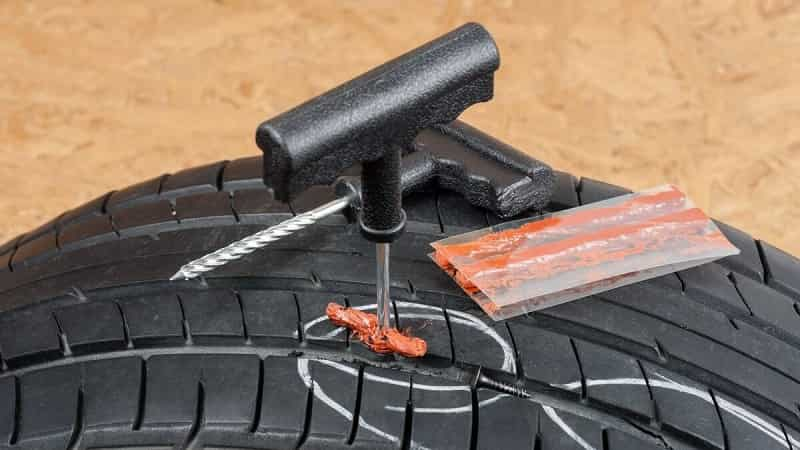
With today's technology, tires are also designed according to modern standards with toughness and good impact resistance on rugged terrain.
Yet, if you are unfortunate enough to have a puncture, you need to perform repair operations with the essential tools and materials as follows:
- Tools: Plug kit, wire cutter, sprayer, pliers, car jack
- Materials: Paper towels, cleaning solution, tire sealing cement.
Here are seven steps to performing the wheel plugging process in case of a leak.
1. Find the damaged location.
If you want to fix it, you have to find the cause of the damaged location. First, you have to find the leak that drains the car's air. You pump air into the wheel, so you should adjust to the wheel to have the right stiffness and tension.
At this point, it is not necessary to remove the wheel from the body altogether, but if you have a jacking tool at hand, it can be available to facilitate later steps.
Then dilute the solution of 20% soap with 80% water, spray the entire one when the puncture location is unknown, the air bubble rises, then that's where there is a leak, which needs to be repaired.
Remove foreign objects that cause puncture if stuck in the tire with pliers.
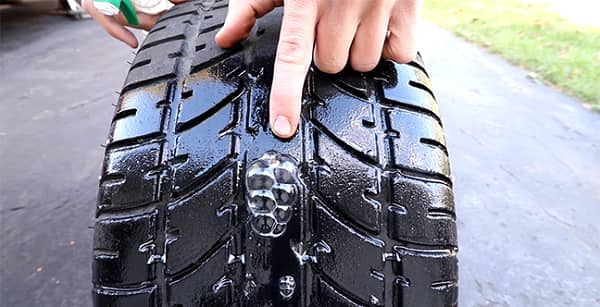
2. Enlarge the puncture hole
This step requires a pair of healthy hands, using a T-handle reamer to do the job of turning the hole.
The continuous rotation of the hole has the effect of roughening the mounting surface and making the hole larger to match the size of the plug.
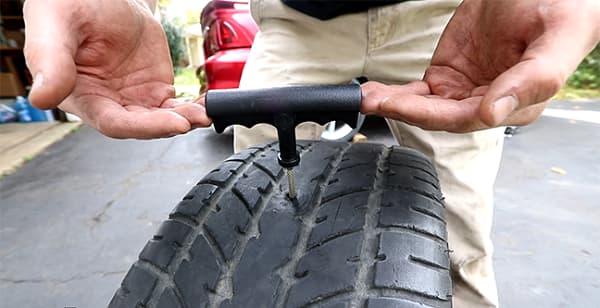
Repeat several times until the desired size is reachable. However, the hole is too small to be used in some cases, so use a hand drill with a small exercise to grind the hole and then continue.
3. Prepare to plug
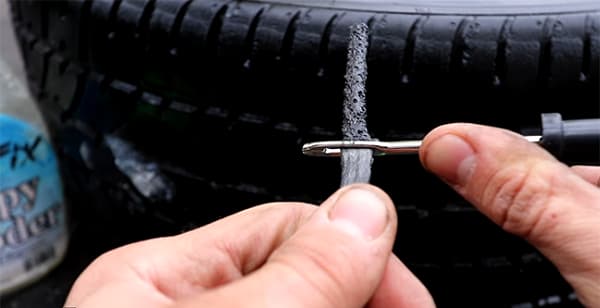
Prepare a suitable strip from the repair kit, thread the plug strip through the mouth of the tool eyelet, then use a fixture such as pliers to adjust the material balance between the ends.
Use cement spray to seal the entire strip, do the same with the puncture.
4. Insert the plug strip
Insert the plug strip slowly into the puncture hole in the tire. With this step, you need a solid hand to press the strip into place on the tire firmly.
Once the strip is fully inserted, you need to pull the tool handle straight up, so that the remaining plug strip is about 1-inch outside the tire.
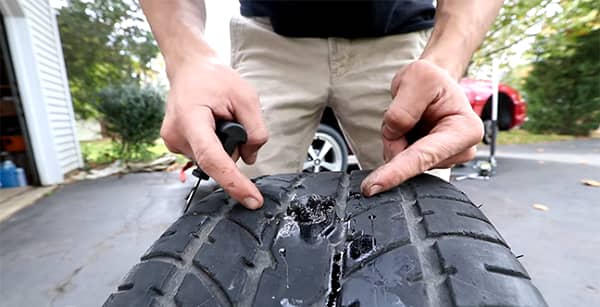
5. Fill the tire with air
Once fully plugged tire, use the air pump to fill the wheel with air. It has the effect of investigating any gas that continues to leak.
A small note is that the air pressure you are pumping in at this point should be less than 10% of the standard PSI.
6. Cut off the excess
The above steps have almost completed 90% of the plugged tire process. Post-production includes the following steps:
- Clean the areas with detergents
- The driver needs to wait about 10-15 minutes for the glue to dry
- And finally cut off the excess edges of the plug, leaving a gap of about ⅛ inch.
7. Check the plugged tire for the last time
Still using a dilute solution of water to spray the entire tire, not only to ensure the quality of the plug but also to check other existing areas on the wheel for the same condition.
You can then lower the car, remove the jack and you can continue the ride
Originating from the question of how long the plug should be available, many people doubt the authenticity and effectiveness of the tire plug method.
However, through surveys, the wheels are entirely smooth, the wheels are still solid when running on long distances.
Therefore, the fact that your car has tires plugged in does not affect the movement much, and it even increases the endurance of the wheel itself. And don't forget to always prepare the spare tire in case it needs to be.
Is It Safe To Drive With A Plugged Tire?
It shouldn't be a problem if you've been driving the car with the plugged tires on for a short, moderate period.
But the advice we give is to limit the use of tires that appear to have large plugs located near the tire wall when traveling in for a long time. Accordingly, the emergency tire plug can only be used on the tire surface and cannot repair the hole in the tire wall.
Plug tires should not be used to transport heavy items, which puts a lot of pressure on the tires wall, will damage the tires quickly.
1. Is A Tire Plug Permanent?
Using a tire plug to repair a puncture is a quick solution in all situations. But this is not a long-term or permanent solution because the sealed plug cord also has a shelf life; the main effect is only to temporarily fix the hole and prevent air from leaking out.
Over time, many external influences can cause the tire plug to shrink or the hole to expand, causing an imbalance between the two objects.
So to ensure safety, each fixed cycle, you go to car maintenance centers to strengthen the wheels more firmly.
2. Can Tire Plugs Go Bad?
Tire holes are not easy to damage, but it is an imperfect repair method. Its working principle is to fill the air inside the tire without completely sealing it.
Besides, it can have fluctuations that adversely affect your tires over time.
When Should You Not Plug A Tire?
Although knowing that plugging in a tire is a proper quick method, in some specific cases, it is not an intelligent choice such as:
When the crack is too big, the gravity from the vehicle's body and the frictional pressure from the road surface make the tire unable to stand during the movement.
The following case is that the wheel has too many holes. We recommend replacing it with a new one or going to the center for more reliable service.
And as mentioned above, when the puncture site is in the tire wall, you can't operate the tire plugging.
For more detailed information, you can watch this video below!
Video created by: FortNine
Conclusion
We hope that with the above knowledge about how to plug a leaky tire, you will have a better overview of safety issues in driving and how to handle accidents when driving problems as above. And don't forget to share this knowledge for everyone to learn. Thanks very much!
I’m Ivo Gievski, the content writer for Tireer. We built our website with over 15 years of experience and extensive research in the automotive and technology sectors. My dedication to delivering high-quality content is unwavering, and I strive to continuously hone my skills to stay ahead of industry trends and provide readers with informative, engaging, and valuable insights.
A tire plug can last 7 to 10 years if properly installed and the driving conditions are not harsh. So driving on a plugged tire is safe, but only for short distances. You have to find the nearest tire service center for a proper repair, which should be your priority.